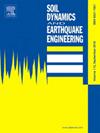土袋、桩和基脚组成的复合地基原位加载试验的数值模拟
IF 4.2
2区 工程技术
Q1 ENGINEERING, GEOLOGICAL
引用次数: 0
摘要
作者一直在开发一种由土袋、桩和基脚组成的新型复合地基,以下称为拟议复合地基(PCF)。PCF 的特点是在桩头和基脚之间铺设土袋。PCF 的预期效果是通过切断桩与基脚之间的固定连接,减少地震时桩的弯矩和墩的响应加速度。要将 PCF 应用于实际工程,有必要通过与之前原位加载试验确认的 PCF 整个系统的地震行为进行比较,以确认 PCF 数值分析模型的有效性。因此,本研究基于合理弹塑性模型进行有限元分析,以重现原位加载试验,并通过比较计算结果和试验结果来验证数值模型。此外,由于在实际工程中进行复杂的弹塑性有限元分析并非易事,因此提出了一种简化的数值方法,并通过将试验结果与弹塑性有限元分析结果进行比较,检验了该方法的适用性。结果表明,虽然并非所有的原位加载试验结果都能得到解释,但所提出的简化方法总体上可以解释试验结果,对新提出的 PCF 的实际工程非常有用。本文章由计算机程序翻译,如有差异,请以英文原文为准。
Numerical simulation on in-situ loading tests of composite foundation composed of soilbags, piles and footing
The authors have been developing a new composite foundation composed of soilbags, piles and footing, hereafter called as proposed composite foundation (PCF). PCF is characterized by laying soilbags between the pile heads and the footing. The expected effects of PCF are to reduce the bending moment of the piles and the response acceleration of the pier during earthquakes by cutting off the fixed connection between the piles and the footing. To apply PCF to practical use, it is necessary to confirm the validity of the numerical analysis model of PCF through comparison with the seismic behavior of the entire system of PCF confirmed by the previous in-situ loading tests. In this study, therefore, FEM analysis based on rational elastoplastic model was conducted to reproduce the in-situ loading tests, and the numerical model was verified by comparing the calculation results to the test results. Furthermore, since it is not always easy to conduct sophisticated elastoplastic FEM analysis in practical engineering, a simplified numerical method is proposed, and its applicability was examined by comparing to the test results and the elastoplastic FEM analysis results. The results showed that, although not all the results of the in-situ loading tests could be explained, the proposed simplified method could generally explain the test results and was useful for the practical engineering of the newly proposed PCF.
求助全文
通过发布文献求助,成功后即可免费获取论文全文。
去求助
来源期刊

Soil Dynamics and Earthquake Engineering
工程技术-地球科学综合
CiteScore
7.50
自引率
15.00%
发文量
446
审稿时长
8 months
期刊介绍:
The journal aims to encourage and enhance the role of mechanics and other disciplines as they relate to earthquake engineering by providing opportunities for the publication of the work of applied mathematicians, engineers and other applied scientists involved in solving problems closely related to the field of earthquake engineering and geotechnical earthquake engineering.
Emphasis is placed on new concepts and techniques, but case histories will also be published if they enhance the presentation and understanding of new technical concepts.
 求助内容:
求助内容: 应助结果提醒方式:
应助结果提醒方式:


